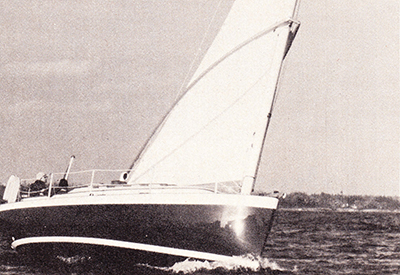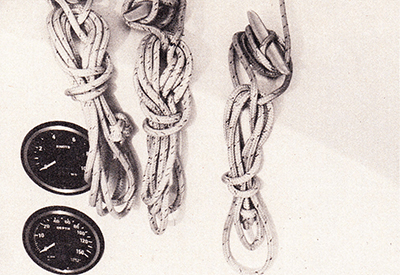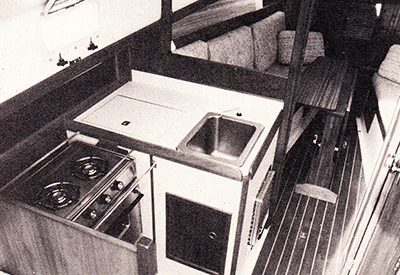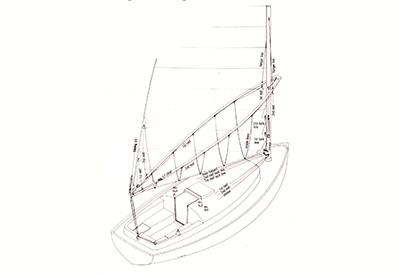Nonsuch 26
By John Turnbull
A single hander’s family cat. Simplicity is really the key to the Nonsuch concept, and it takes some getting used to. For someone brought up to think that unless he is pulling a line or wrestling a sail he isn’t having a good time, being allowed to sit in the cockpit like a passenger can be unnerving.
A talented promoter, Gary Hoyt, changed the way North American yacht owners regard the unstayed mast when he designed the Freedom cat ketch, but it remained for designer Mark Ellis to apply the unstayed concept in a practical, efficient way in his Nonsuch 30. Now, six years after unstayed catboats began appearing on the scene, it is the Nonsuch cats, built by Hinterhoeller Yachts, that can be considered the standard. The Nonsuch 30 can be found in harbours all over the continent, but enjoys particular popularity on Long Island Sound. There is a nice irony in this; that a Canadian built boat has won approval in the historical capitol of cat boat sailing.
In a season that will see the introduction of two more Nonsuch cats, the 22 and the long awaited 36, we decided to take a closer look at the popular Nonsuch 26. Since hull number one was first launched in the spring of l981, 103 Nonsuch 26s have been built, mainly for owners on Lake Ontario and Long Island Sound.
 Hinterhoeller, at Niagara-on-the-Lake, has brought the balsa- cored laminate construction technique to a high state of development, and their busy plant, with its unique boat bays where assembly and final fitting work is done, has to be rated as one of the most efficient in North America. That care for production techniques, allowing time and facility for the hand fitting work to be done properly, was evident in the Nonsuch 26 we sailed late in the season last fall.
Hinterhoeller, at Niagara-on-the-Lake, has brought the balsa- cored laminate construction technique to a high state of development, and their busy plant, with its unique boat bays where assembly and final fitting work is done, has to be rated as one of the most efficient in North America. That care for production techniques, allowing time and facility for the hand fitting work to be done properly, was evident in the Nonsuch 26 we sailed late in the season last fall.
Late season sailing can be a pleasure. It can also be cold and wet, but the comfort provided by the 26 on a sunny, but chilly day in October is a good starting point. We arrived to find the Nonsuch nearly alone at Bronte Harbour, most of the other boats having been hauled and covered weeks before. The owner, Mark Lowry, who also rep resents the Nonsuch line as a salesman for Harris and Ellis, had been taking advantage of the frequent sunny weather by slipping out late in the afternoon, often single handing. There are few boats so easy to sail that their owners actually can get away on short notice, and what a difference it makes to the amount a boat is sailed during the season.
 The propane heater was fired up and the cabin, despite the hatch being open to a chilly breeze, was warm and comfortable. Four of us, with our bulky coats and sweaters spread about, had plenty of room to stretch and enjoy lunch. Since there is no mast imposing itself on the layout (the mast, of course, is in the bow, separated from the interior by a bulkhead) there is no need to turn the forward interior over to the standard V-berth configuration with its dark, cramped space. The effect is that, in most respects, the 26 seems much larger than it should. Where this layout really pays off, however; is in the use of a light panel that slides up and locks in position, closing off the forward part of the cabin from the aft end for sleeping.
The propane heater was fired up and the cabin, despite the hatch being open to a chilly breeze, was warm and comfortable. Four of us, with our bulky coats and sweaters spread about, had plenty of room to stretch and enjoy lunch. Since there is no mast imposing itself on the layout (the mast, of course, is in the bow, separated from the interior by a bulkhead) there is no need to turn the forward interior over to the standard V-berth configuration with its dark, cramped space. The effect is that, in most respects, the 26 seems much larger than it should. Where this layout really pays off, however; is in the use of a light panel that slides up and locks in position, closing off the forward part of the cabin from the aft end for sleeping.
The head is very large for a 26-foot hull and enjoys the widest part of the beam and maximum headroom, situated opposite the galley.
We left the harbour under power and as we stowed the fenders and coiled the lines, I began to realize how much use is made of standing rigging on a conventional boat just for holding on. Working the deck on a Nonsuch is seldom: necessary – there’s not much to do except take in lines, but it does require a different approach to staying on the boat.
When we reached the harbour mouth, Mark insisted on setting the sail himself to demonstrate how unnecessary we were as crew. With the sail resting in lazy jacks, he hauled the halyard on a winch at the forward end of the cockpit. Once that was done. he merely adjusted the lines controlling the position of the wishbone boom (and therefore the shape of the sail, in the manner of an outhaul), and we were underway The fact that there was a fairly lumpy slop and about 15 knots of wind did not seem to complicate matters.
For the person actually doing the sailing, it’s a tremendous advantage to know that regardless of how skilled his passengers may be, he can still handle the boat in almost any situation.
 It also means that you can go sailing by yourself. The advantage here is not just that the rig is easy to handle, but that, as a single hander; you won’t be spending any time on deck except at the dock. That alone makes the Nonsuch a far safer type to sail than any conventional sloop. In cool weather; it also means that you can stay back in the large cockpit where it’s relatively warm and dry.
It also means that you can go sailing by yourself. The advantage here is not just that the rig is easy to handle, but that, as a single hander; you won’t be spending any time on deck except at the dock. That alone makes the Nonsuch a far safer type to sail than any conventional sloop. In cool weather; it also means that you can stay back in the large cockpit where it’s relatively warm and dry.
Going upwind in a moderate sea was quite exhilarating. Like any boat without a headsail, the Nonsuch takes a different kind of handling going to weather. The issue of upwind performance of a cat versus a sloop won’t be resolved here, but certainly any differences in speed made good – if, indeed, there are any – are just not important to the cruising sailor. Balanced against the lack of a luff unencumbered by the mast, has to be weighed the greater height of the luff on a cat and the generally cleaner rig. In the end, what really counts, in both cases, is the match between the rig and the foil of the keel, and this, on the Nonsuch, seems to be just right. We tacked easily within 80 degrees and had just as wide a choice of pointing angles as on a conventional rig.
Choosing the angle, however, takes some practice. Without ticklers on the jib luff, I had to pay more attention to the feel of the boat – not an unpleasant way to sail, once you get used to it.
Off the wind, the Nonsuch really is a pleasure. That huge sail area, all und er the control of one sheet, unfettered by shrouds and free from the backwinding so often created by a headsail that can’t be given a wide enough sheeting base, really takes the bit in its teeth and pulls. Riding over the seas with all that area grasped in one hand, and no need to cajole an inexpert crew to trim constantly, is an exciting way to sail. The hull’s large volumes in the bow (to support the forward weight of the mast) and in the stem create an unusually long wave for a 26-footer. Surprisingly, the helm did not show any unusual weather tendency and the large freestanding rudder was easy to control.
 Straight downwind, the Nonsuch, like any boat without a spinnaker; can be rather unexciting. Some will consider this an advantage. Certainly the reputation held by traditional cats for being hard to steer on a run just doesn’t apply here. The reason for this may have to do with the fact that the unstayed mast allows the sail to be set much further out so that it pulls well forward and parallel to the course. Full lines forward, rather than the traditional hollow bow and the larger, more efficient rudder on the Nonsuch also help, I’m sure.
Straight downwind, the Nonsuch, like any boat without a spinnaker; can be rather unexciting. Some will consider this an advantage. Certainly the reputation held by traditional cats for being hard to steer on a run just doesn’t apply here. The reason for this may have to do with the fact that the unstayed mast allows the sail to be set much further out so that it pulls well forward and parallel to the course. Full lines forward, rather than the traditional hollow bow and the larger, more efficient rudder on the Nonsuch also help, I’m sure.
The wishbone, whose real virtue is that it can be ignored, has an unexpected advantage on the run. Since it is lighter and suspended by its control lines rather than bolted to the mast, it doesn’t slap and bang nearly as much as conventional booms do downwind in a sloppy sea.
Gybing, of course, is simply not an issue with the wishbone. You need hardly warn anyone that it’s going to happen beca use the sail just sweeps overhead. There is, on the other hand, an awful lot of mainsheet to contend with (the boom is much longer than on a sloop and it goes further out) and I wonder whether there is any simpler way of getting the required purchase without using quite so much rope.
Finally, the real test for any cruising rig: how difficult is it to shorten sail? As you might have guessed, on the Nonsuch it’s very easy. This by the way, is where the difference between Mark Eilis’s and Gary Hoyt’ s designs really shows. The Nonsuch does not use a sleeve sail (the latest Freedom design doesn’t either, incidentally) so that the cloth doesn’t bunch up at the bottom of the spar, but collects on the track the way any ordinary mainsail does. Reefing, then, is a matter of loosening the control lines on the wishbone and lowering the halyard to allow the sail to drop into the lazy jacks (angle to the wind is not crucial). Once the downhauls are taken up, you’re done. The crew, in the meantime, has probably helped hold the bow into the wind-that, at least, takes a little more skill than on a sloop with its finer bow.
All the Nonsuchs are handsome boats despite their fairly high freeboard and a sheer that’s less exaggerated than the classic cat boat sheer. I find the transom a little broad, but it’s a fair trade for the length and width of the cockpit. Details of trim are very well handled and make all the difference to the overall impression. Like all Hinterhoeller boats, the Nonsuchs are produced to a higher level of quality than what seems to be the norm. They’re not inexpensive by any means, and they attract a buyer who is very confident that he wants an unusual, distinctive boat – one that cruises comfortably whether or not the crew is willing and able.
The main on the Nonsuch is very simple for a single hander to manage- and much easier than it looks! The sequence begins with slackening the choker line to ease the wishbone. Then the sail is raised with the main halyard and the halyard is trimmed and cleated. Finally, the choker line is adjusted for the right amount of draft. To lower the main the sequence is reversed. The sail will flake itself into the cradle lines as the main halyard is run up the mast.
Reefing is delightfully simple. When the choker line is slackened and the main halyard lowered, excess sail will flake into the cradle lines. Then the first tack line is hauled in and cleated, bringing the new tack to the tack fitting. Once again the main halyard is tightened and cleated and the first reef line is hauled in and cleated. Last, the choker line is adjusted again for the correct draft.
Originally published in Canadian Yachting’s June 1983 issue.
SPECIFICATIONS:
Length Overall: 26 ft
Beam: 10 ft 6 in.
Displacement: 8,500 lbs
Ballast: 2,750 lbs
Draft: 4 ft 6 in.
Shallow draft: 3 ft 9 in.
Water tank: 2×30 US. gal.
Total sail area: 420 ft2
Masthead above waterline: 49 ft
PHOTO CAPTIONS:
Photo 1 – Under Sail
Photo 2 – Choosing the pointing angle on a cat rig requires some practice and getting the feel of the boat.
Photo 3 – Halyards on the Nonsuch can be controlled from the cockpit, top right, making deck work unnecessary except when handling lines.
Photo 4 – In its large, warm interior, lower right, the 26 contains the space of a much larger boat-even in the head, which allows optional pressurized hot water.
Photo 5 – Working the wishbone rig.























